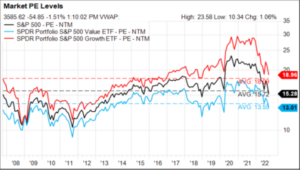Market & Economic Commentary– October 2022
October 12, 2022
By, Peter Mueller & Steve Taddie
The liquid investment markets have not put in a very good year to date. Whether it be value stocks, growth stocks, or bonds – values are lower across the board. Liquidity and valuation variability go hand-in-hand, as typically you cannot have one without the other. We like the change in valuation when prices go up and hate it when prices go down. For company or industry specific issues, typically an investor owns the same asset they liked or loved at the time of investment, and the only thing that has changed is the market’s current measure of value. In the end, one has to be comfortable with, or at least tolerate the changing valuations. For now, there are more questions than answers, as the market operates with a lot of emotion, and currently emotions are fragile, as future inflation, current and future interest rates, future earnings, and multiple geopolitical issues are in the headlines.
On the economic front, stubbornly high inflation readings have yielded more hawkish rhetoric and higher terminal interest rate estimates from voting members of the Federal Reserve. As the Fed was slow to respond to inflation pressures in late 2021 and early 2022, they have been raising interest rates at a rapid trajectory to “front load” monetary policy. Currently, the terminal rate expectations from the Fed are 4.5% to 4.75%– of course where the rates finally land will depend on incoming economic data. These outsized rate hikes, and the fact the Fed continues to move the goal posts regarding the terminal rate, has put markets on edge as financial conditions tighten. Complicating the picture, the economy is slowing this year and areas such as Europe are already in recession. Therefore, the Feds tighter interest rate trajectory can accelerate the slowdown and increases the odds of recessionary conditions.
The inflation year-over-year data points will grab the headlines, but it is the month-over-month data points that will offer the best guidance for future inflation rates. On a month-over-month basis, headline CPI has been flat for the last two months, and September’s report is due this week. If CPI follows the trend of commodity prices and other inputs to inflation over the last three months, we should get confirmation that upward price pressures are subsiding. The Federal Reserve has said they are data dependent, and the stock market seems to feel the odds of a policy mistake from a hawkish Fed has steadily increased, which would be consistent with a view that their current jawboning will convert to continued rate increases, that would remain higher for longer.
Another byproduct of the Fed’s telegraphed interest rate policy – interest rates higher for longer – is a surge in the US dollar. Since the 1970s, during periods of US dollar strength, inflation in the US has not accelerated. The inflation/dollar comparison below shows the history, and the current anomaly. US dollar strength typically exerts upward pressure on inflation in other countries. Russian driven energy supply issues have taken center stage creating an outsized impact on inflation in European countries, accentuating the upward pressure from a strong US dollar.

While the focus will remain on inflation and the Fed’s monetary policy, it is now moving to corporate earnings. Earnings are facing pressure from inflation, the strong dollar, inventory issues, and in some cases declining demand. S&P 500 earnings estimates decreased a mere 3 ½% over the last 3 months and so far, analysts have not thrown in the proverbial towel, yet.
On the valuation front, the price/earnings (P/E) ratio for the S&P 500, growth stocks and value stocks sit at their 15-year average level as seen in the graph below. If the economy continues at current activity levels, the valuation levels do not look overly expensive. If the Fed continues to drive business activity lower using the Fed Funds rate sledgehammer, a resulting recession (not a soft landing) could reduce earnings making current valuations levels look a bit elevated. As earnings season begins this week, the results and guidance will sharpen the valuation assessment in context to the business cycle.

Where does all this leave us? A complicated and in many ways inconsistent picture – all of which creates more uncertainty, increased price volatility, and pressure on asset values. Markets are cyclical in nature, and declines, corrections, and bear markets are normal. In fact, the decline has already reached the median decline seen in post-WWII recessions – thereby signaling those markets have already discounted a mild recession (source: Goldman Sachs). Typically, when these down cycles terminate, the equity returns in the year after past bear markets have been well above average.
Markets have been a rough place to be this year, but we have gone through periods like this many times before, and we will go through periods like this in the future. Bear markets do end, and this one will as well. During times like these, professional managers sort through their holdings to ensure they are holding the right assets at the right allocation for when the tide turns – focused on investment quality and cash flow. As equity markets typically bottom 6 to 9 months before earnings reach a trough or 3 months before a the end of a recession, we may be getting closer to markets making a sustainable turn. Patience, while a virtue, is sometimes painful in the short-term.
All the Best,

![]()
Steve Taddie Peter Mueller
The discussions and opinions in this correspondence are for general information only and are not intended to provide investment advice. While taken from sources deemed to be accurate, HoyleCohen makes no representations about the accuracy of the information in the letter or its appropriateness for any given situation. HoyleCohen’s quarterly statements are provided as a convenience and we encourage clients to refer to custodian statements as well.

